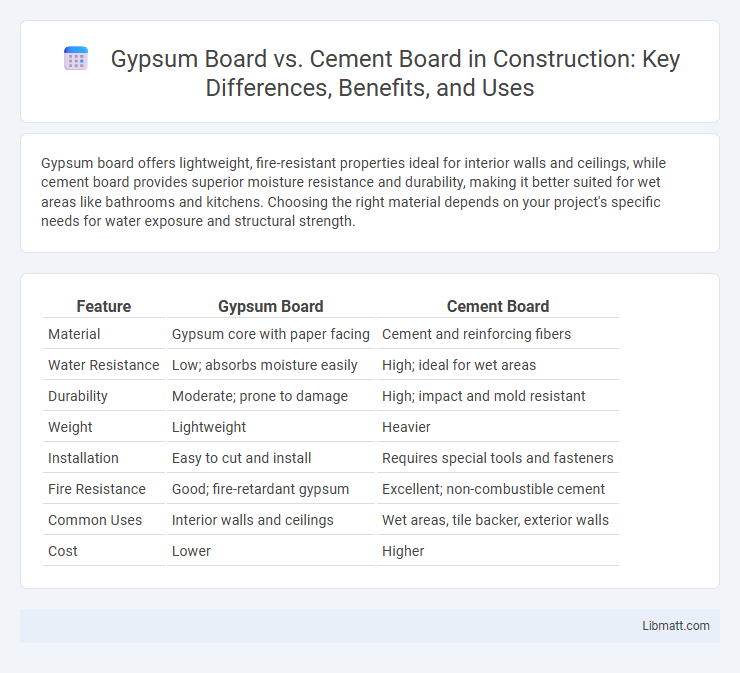Gypsum board offers lightweight, fire-resistant properties ideal for interior walls and ceilings, while cement board provides superior moisture resistance and durability, making it better suited for wet areas like bathrooms and kitchens. Choosing the right material depends on your project's specific needs for water exposure and structural strength.
Table of Comparison
| Feature | Gypsum Board | Cement Board |
|---|---|---|
| Material | Gypsum core with paper facing | Cement and reinforcing fibers |
| Water Resistance | Low; absorbs moisture easily | High; ideal for wet areas |
| Durability | Moderate; prone to damage | High; impact and mold resistant |
| Weight | Lightweight | Heavier |
| Installation | Easy to cut and install | Requires special tools and fasteners |
| Fire Resistance | Good; fire-retardant gypsum | Excellent; non-combustible cement |
| Common Uses | Interior walls and ceilings | Wet areas, tile backer, exterior walls |
| Cost | Lower | Higher |
Introduction to Gypsum Board and Cement Board
Gypsum board, composed mainly of gypsum plaster sandwiched between paper layers, offers lightweight and fire-resistant properties ideal for interior walls and ceilings. Cement board consists of a mixture of cement and reinforcing fibers, providing superior moisture resistance and structural strength for wet areas like bathrooms and kitchens. You should choose gypsum board for drywall applications and cement board when durability against water and impact is essential.
Composition and Material Properties
Gypsum board consists primarily of a gypsum core sandwiched between paper facings, making it lightweight, fire-resistant, and easy to cut, ideal for interior walls and ceilings. Cement board is made from a mixture of cement and reinforcing fibers, providing superior moisture resistance, durability, and strength, suitable for wet areas like bathrooms and exterior applications. Understanding the material properties helps you choose the right board based on the environmental conditions and structural requirements of your project.
Installation Processes Compared
Gypsum board installation involves cutting panels to size, securing them with drywall screws to wooden or metal studs, and finishing with joint tape and compound for a smooth surface. Cement board requires precise cutting with a carbide-tipped blade, fastening with corrosion-resistant screws or nails, and sealing joints with mesh tape and thin-set mortar to enhance moisture resistance. Cement board installation demands more labor and time due to its heavier weight and specialized materials, making it ideal for wet areas where durability is crucial.
Moisture and Water Resistance
Gypsum board offers limited moisture resistance, making it unsuitable for high-humidity environments or direct water exposure, as it can absorb moisture and deteriorate quickly. Cement board, composed of cement and reinforcing fibers, provides superior water resistance and is ideal for wet areas like bathrooms, kitchens, and exterior applications. Its durability against mold, mildew, and water damage makes cement board a preferred choice where moisture control is critical.
Fire Resistance and Safety Features
Gypsum board offers excellent fire resistance due to its core containing chemically combined water that slows heat transfer and helps prevent fire spread. Cement board is also fire-resistant and excels in high-moisture environments, containing no organic materials that could ignite or promote mold growth. Both materials meet stringent safety standards, but gypsum board is often preferred in interior applications for fire-rated walls, while cement board is favored where enhanced durability and moisture resistance are critical.
Durability and Longevity
Gypsum board offers moderate durability primarily suited for interior walls and ceilings, but it is susceptible to moisture damage and can deteriorate over time in wet environments. Cement board provides superior durability and longevity, excelling in moisture resistance, impact resistance, and structural stability, making it ideal for areas exposed to water such as bathrooms and kitchens. Choosing cement board for your project ensures a longer-lasting, more resilient surface compared to gypsum board.
Cost Comparison and Budget Considerations
Gypsum board typically costs less than cement board, making it a more budget-friendly option for interior walls and ceilings. Cement board, although pricier, offers greater durability and moisture resistance, which can reduce long-term maintenance expenses in wet or high-traffic areas. Your choice depends on balancing upfront material costs with the specific performance needs of your project to optimize overall budget efficiency.
Applications and Best Use Cases
Gypsum board is ideal for interior walls and ceilings in residential and commercial buildings due to its lightweight, ease of installation, and fire resistance. Cement board is best suited for high-moisture areas like bathrooms, kitchens, and exterior applications because of its superior water resistance, durability, and mold resistance. Choosing gypsum board or cement board depends on environmental conditions and specific project requirements to ensure long-lasting performance.
Environmental Impact and Sustainability
Gypsum board is made primarily from natural gypsum, which is recyclable and has a lower embodied energy compared to cement board, making it a more sustainable option for indoor environments. Cement board, composed of cement and reinforcing fibers, has a higher carbon footprint due to the energy-intensive cement production process and is less biodegradable. Your choice affects environmental impact significantly, with gypsum board offering better recyclability and lower emissions, while cement board provides durability but with greater ecological costs.
Conclusion: Choosing the Right Board for Your Project
Gypsum board excels in interior applications due to its lightweight, ease of installation, and fire-resistant properties, making it ideal for walls and ceilings in dry environments. Cement board, offering superior moisture and mold resistance, is the preferred choice for wet areas such as bathrooms, kitchens, and exterior applications where durability is crucial. Selecting the right board depends on the specific environmental conditions and functional requirements of your project to ensure longevity and performance.
Gypsum board vs cement board Infographic

 libmatt.com
libmatt.com